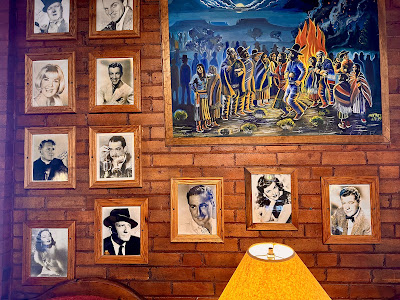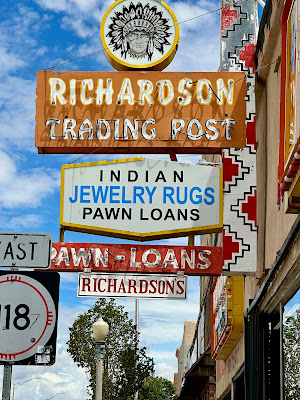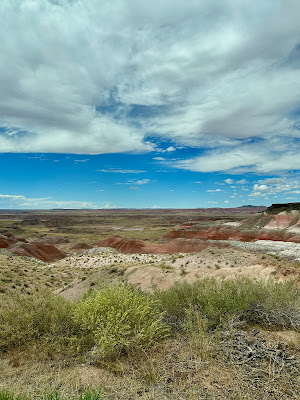Earlier this month I took a road trip with a friend along parts of historic Route 66 from Flagstaff, AZ, to a pow wow in Gallup, New Mexico. It was the 101st Gallup Inter-Tribal Indian Ceremonial, a two-week celebration of Native American culture and and heritage, and it was spectacularly colorful!
But first was breakfast at the beautifully restored La Posada ("The Resting Place") in Winslow, Arizona. It started as a Fred Harvey luxury railroad hotel in 1930 designed by famed architect Mary Colter, who also designed buildings at the Grand Canyon. Later it was nearly gutted and turned into railroad offices then fell into disrepair before being lovingly restored by its current owner. It's still a work in progress. For more info: the-history-of-la-posada
The dining room has turquoise ceiling beams and the walls are full of art. My orange crepes stuffed with cottage cheese were divine.
Then we walked down the street to check off one of my bucket list items: "Standing on the corner in Winslow, Arizona" with the Jackson Browne statue! Businesses in Winslow have milked this for all it's worth, although my friend Don, a historian from Flagstaff, says that Jackson Browne actually stopped in Flagstaff, not Winslow. The story goes that Glenn Frey of the Eagles, who finished Browne's song when Browne got tired of writing it, thought Winslow sounded more melodic than Flagstaff.
Holbrook was another of our stops along old Route 66. The businesses that boomed when 66 went through suffered later when I-40 was built, bypassing the towns. But we stopped to view the old cars at the once-famous cement teepee hotel.
And the stop wouldn't be complete without going to Painted Desert Quilts, where I educated Don about fat quarters, jelly rolls, layer cakes and charm packs. It was his first time in a quilt shop. I bought a charm pack to make another baby quilt for my granddaughter, who's due in January.
When we finally reached Gallup, we went straight to another historic hotel -- El Rancho -- to soak up the Southwest atmosphere and have a late lunch/early dinner before going to the pow wow's evening festivities.
El Rancho opened in 1937 as a base for movie productions and was a haven for movie stars in the 1930s and '40s whose photos adorn the walls. But it was another victim of I-40 until the Ortega family bought and restored it. The hotel is now full of Southwestern charm and warmth ...
... and delicious food in the restaurant.
We each had Mexican.
Then it was on to the pow wow at Red Rock Park where we enjoyed Native American art that included paintings, jewelry, rugs, baskets, katsina dolls and more. I can't believe I didn't get pictures! I think I was just overwhelmed by so much stimulation that I forgot to take photos.
Next, we gathered with hundreds of others to wait for the Grand Entry parade and traditional night performances with dancing and drumming. We heard shots echoing off the massive red cliffs around us and assumed it was to mark the beginning of the ceremonies -- but it wasn't. The crowd started rushing away en masse because security thought there might be a shooter in the area. We were sequestered inside the art building away from windows until it was determined that there was no danger, but by then it was pouring rain, the evening's festivities were canceled and we were all told the leave. It was sort of exciting! The shots were from someone practicing target shooting on a nearby property.
Saturday's parade (above) through downtown Gallop made up for the lack of festivities the night before. And later in the day there was traditional dancing in colorful costumes with feathers flying and drums pounding.
We had looked forward to seeing the Danza de los Voladores (also known as the Flying Voladores), but high winds cut the performance short after they had climbed to the top of the nearly 100-foot-tall pole. Below is a photo of what the ancient spiritual Mexican ceremony involves, with the flying men slowly descending to earth as they rotate around the pole. The fifth man plays music at the top.
We also browsed at least half a dozen trading posts that carried an enormous amount of turquoise jewelry as well as other native art and crafts. I bought a simple pair of turquoise and silver hoop earrings.
The next day we headed back to Flagstaff with more stops along Route 66. I had never been to the Petrified Forest National Park, and I loved the colors and historical building.
This is my kind of sky --
wide open over a desert landscape.
Petroglyphs in the park were carved from 650 to 2,000 years ago by Pueblo people who farmed and hunted in the area. There is an astonishing number, probably carved over many generations. This first site is called Newspaper Rock because there are so many petroglyphs.
The famous chunks of petrified wood glisten with colors created when the wood was replaced with stone through mineralization.

I really enjoyed the Painted Desert Inn, which has been turned into a museum complete with rocking chairs, and a jukebox and ice cream counter in the old tap room in addition to the expected historical information and art. The original inn was built of petrified wood in the 1920s, but unfortunately it was built on unstable ground and began to crack. Today's adobe facade dates to a 1930s renovation.

The Salt Lake mural at the inn depicts the story of two young Hopi men on a salt gathering journey who walked a 230-mile trip from their home to the Zuni mesas and back, passing through what is now Petrified Forest National Park. It was both a physical and coming of age ceremony. This is just one of many beautiful art works at the museum.
Then our journey wound to a close as we drove into the sunset toward the San Francisco Peaks of Flagstaff. I'm glad I didn't have to walk!
Have a colorful day








.jpeg)




















Oh my, what a lovely adventure you had! Thanks for sharing all the color and culture!
ReplyDelete